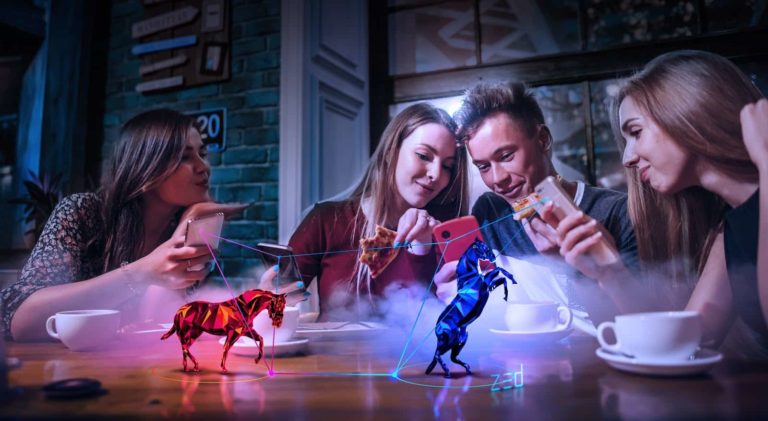
Over the past year the AR market has boomed. This is largely due to rapidly-evolving applications allowing for AR content creation at scale, evolving user behaviors as our personal and professional lives are increasingly online, and the highly publicised commitments of Meta (formerly Facebook). Meta’s investment has been the tipping point for many other brands to follow suit.
Geenee’s Q4 report releasing today explores the evolution of AR and the spatial web. That includes 2022 predictions and the outcomes of last year’s predictions, which we’ve summarized below for AR Insider readers.
Looking Back: 2021 Predictions
Before we look to the future, let’s revisit our predictions from this time last year. 2020 prepared us for an unimaginable year of innovation and digital transformation. Predictions that would, under usual circumstances, take 3-5 years to reach widespread adoption accelerated at an unprecedented rate.
Within weeks, companies integrated web AR into their marketing mix to bring digital activations and storefronts to our homes. These new formats of interactive experiences served consumers newfound and lasting utility. Web AR is bringing more powerful tools to consumers, brands, independent artists and creators alike.
Here’s a summary of what we said last year…
- AR will fill the experiential void as brands shift from physical to digital activations.
- WebAR will show even stronger ROI as we see a wider variety of offerings and experiences specific to the needs of various brands.
- Meme-ing will enter a new dimension as web AR becomes an everyday tool, integrated with pop culture and trends of the moment.
- The QR code will make a comeback.
- The office will become increasingly hybrid, with AR conferencing solutions entering the workplace.
- DIY-3D (do it yourself 3D) as web AR will make special effects accessible to all. Retailers will focus on web AR to boost the bottom line as a seamless app-free access point for consumers.
- AR will become more widespread at the elementary and professional level to drive education with interactive and accessible material.
- Spatial audio will enter the spatial web.
- Our digital identity will fuse with our physical reality or take on entirely new forms as avatars enter the spatial web.
- AI will give superpowers to AR, capitalizing on camera commerce
In each of these instances, we were amazed by the groundbreaking work happening in this space on a global scale. Avatars took the stage in 2021 with many artists using AR to reach their audiences, including Genies and Wolf 3D’s Ready Player Me avatars.
While meme-ing went surprisingly underground, NFTs emerged as seen in demand from NFT artists, personalities and brands working in the space. This is only the beginning of the convergence of blockchain and web AR.
Now, it’s time to look towards the future with our top near-future trends.
Looking Forward: 10 Near-Future Trends
The next few years will be some of the most exciting ones we’ve seen for AR as consumer adoption rises and brands focus on digital campaigns and hybrid live events. We’ll see greater utility for mobile AR, and wider applications as software and hardware collide for everyday AR glasses.
As a whole, Grandview Research projects the AR industry to reach a market size of $340.16 billion in 2028, a 43.8% compound annual growth rate. Encapsulated in this growth are many different applications of AR that will affect our lives in ways previously only accessible to fictional characters.
Let’s take a look at what the future will bring as we enter Web 3.0. Below are key highlights from Geenee’s Q4 report.
1. Wayfinding with WebAR
“Just like how Shopify revolutionized ecommerce by giving every store a digital storefront, wayfinding unlocks opportunities for individuals and businesses on the spatial web.”
2. Augmented Reality Meets the Blockchain
“Access new revenue streams by reaching entirely new demographics for your brand that were previously unsuitable as physical and digital collide.”
3. Hands-Free Displays Gain Traction
“In the long term, tiny contact lenses will become the norm for augmented reality in our world.”
4. 5G and Edge Computing Power the Metaverse
“In the near future, cinematic 3D interactive content will become a part of the invisible tech landscape that augments our world.”
5. Camera Commerce Makes the World Clickable and Shoppable
“Brands using QR codes and augmented reality are capturing new value from audiences using their cameras to search and shop as we enter a new era of camera commerce.”
6. Direct-to-Avatar Marketing
“No one wants to feel like they’re being marketed to, so brands are becoming more like people with influencers and avatars taking the frontline.”
“Solutions like blockchain can authenticate digital goods, verify online identities, and allow for digital assets and avatars to have more freedom to roam from one platform to another.”
7. Education Enters A New Dimension
“Education that can be experienced in the same way that we interact with our 3D world means an education that students can relate to, understand, share, and remember.”
8. Body Tracking For Virtual Try-On
“By boosting customer confidence with an augmented reality retail experience, Rebecca Minkoff’s customers were 65% more likely to place an online order.”
9. Entertainment: Immersive Worlds In Your World
“We’ll soon be able to stream live volumetric video through our browsers for fully augmented, interactive films. Experience these in the world around you or on your table top.”
“Augmented reality and the blockchain will help to close the value gap between platforms and artists, giving up-and-coming artists the opportunity to reach fans and monetize their audience outside and inside of the streaming and label ecosystem.”
10. The Metaverse: A Decentralized and Visual UI
“The combination of artificial intelligence and computer vision will drive the next evolution of the internet that exists off of our screens and mobile devices, and in the world around us.”
So there you have it. 2022 is primed to be a transformative year for immersive technologies. For more depth, read the full report here.
 Anne McKinnon is an XR consultant and writer for Geenee AR.
Anne McKinnon is an XR consultant and writer for Geenee AR.

